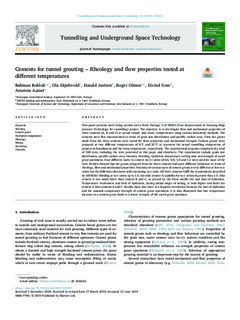| dc.contributor.author | Bohloli, Bahman | |
| dc.contributor.author | Skjølsvold, Ola | |
| dc.contributor.author | Justnes, Harald | |
| dc.contributor.author | Olsson, Roger | |
| dc.contributor.author | Grøv, Eivind | |
| dc.contributor.author | Aarset, Arnstein | |
| dc.date.accessioned | 2019-09-12T09:24:28Z | |
| dc.date.available | 2019-09-12T09:24:28Z | |
| dc.date.created | 2019-07-01T14:57:22Z | |
| dc.date.issued | 2019 | |
| dc.identifier.issn | 0886-7798 | |
| dc.identifier.uri | http://hdl.handle.net/11250/2616524 | |
| dc.description.abstract | This paper presents work being carried out in Work Package 3 of TIGHT (True Improvement in Grouting High pressure Technology for tunnelling) project. The objective is to investigate flow and mechanical properties of three cements (A, B and C) at actual tunnel- and room –temperatures using various laboratory methods. The cements were first characterized in terms of grain size distribution and specific surface area. Then the grouts made from the three cements were tested for flow properties and mechanical strength. Cement grouts were prepared at two different temperatures of 8 °C and 20 °C to represent the actual tunnelling temperature of projects in Scandinavia and the room temperature, respectively. The experimental program comprised of a total of 590 tests, including the tests presented in this paper and elsewhere. The experiments include grain size distribution, specific surface area, viscosity, bleeding, hydration temperature, setting time and strength of cured grout specimens. Four different water to cement (w/c) ratios of 0.6, 0.8, 1.0 and 1.2 were used for most of the tests. Results showed that the grouts prepared from the three cements had quite different behaviour in terms of rheology, flow and mechanical properties. Viscosity of various types of cement grouts is very different at low w/c ratios but the difference decreases with increasing w/c ratio. All three cements fulfil the requirements described by ASTM for bleeding at w/c ratios up to 1.0, but only cement A qualifies for w/c ratios of greater than 1.0. Also cement A sets much faster than cement B and C, as proved by the Vicat needle test and heat of hydration. Temperature evolvement and heat of hydration, during initial stages of setting, is both higher and faster for cement A than cements B and C. Results show that there is a negative correlation between the heat of hydration and the uniaxial compressive strength of cement grout specimens. It is also illustrated that fast temperature increase in a cement grout leads to a lower strength of the cured grout specimen. | |
| dc.language.iso | eng | |
| dc.title | Cements for tunnel grouting – Rheology and flow properties tested at different temperatures | |
| dc.type | Peer reviewed | |
| dc.type | Journal article | |
| dc.source.volume | 91 | |
| dc.source.journal | Tunnelling and Underground Space Technology | |
| dc.identifier.doi | 10.1016/j.tust.2019.103011 | |
| dc.identifier.cristin | 1709090 | |
| dc.relation.project | Norges forskningsråd: 236676 | |
| cristin.unitcode | 7452,4,5,0 | |
| cristin.unitcode | 7452,2,0,0 | |
| cristin.unitcode | 7452,2,3,0 | |
| cristin.unitname | Petroleumsgeomekanikk og geofysikk (PGG) | |
| cristin.unitname | Bygg, anlegg og samferdsel | |
| cristin.unitname | Ingeniørgeologi og bergteknikk | |
| cristin.ispublished | true | |
| cristin.qualitycode | 1 | |
